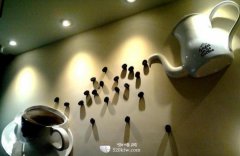Starbucks enters third-tier cities

For more than a decade, McDonald's has attracted a lot of attention when it enters China's second-tier and third-tier cities and now enters fourth-tier and fifth-tier cities or towns. If you live in a city or town with McDonald's, it's a sign of a modern and cosmopolitan lifestyle. It also means that the disposable income of residents in your city or town has reached a certain level and they can afford McDonald's. This is exactly what we know as a well-off society-a modern emerging middle class that means having a small surplus to spend on other products in addition to basic daily expenses. By surveying retail markets and analysing new growth in heartland economies, Mintel has found that McDonald's (and KFC) growth partly reflects rising incomes and expanding aspirations in China.
McDonald's and KFC are everywhere. Instead of dwelling too much on well-off societies, we now focus on the emerging middle class, which means further growth in consumer incomes, spending and ideals. And I think Starbucks is now a new symbol of the development of third, fourth and fifth tier cities. They will certainly expand aggressively-their chain is expected to grow to more than 1500 stores in 70 Chinese cities by 2015. Moreover, the fastest growing cities are the second, third and fourth tier cities, which are crazy about RMB in the pockets of the emerging middle class.
Starbucks may be struggling in some international markets, but it's doing fine in China. Overall, coffee shops are growing rapidly across China-a market currently valued at Rmb3bn and expected to grow to about Rmb5bn by 2015, according to Mintel research. Crucially, Starbucks 'profit per cup is higher in China than in most other major markets, and China is the company's cash cow. And now if a Starbucks opens in a town, it marks a well-off town.
As the saying goes, a mouse poop spoils a pot of soup (or a latte). But the high-margin coffee hasn't made Starbucks comfortable in China-rising rents, labor costs, raw material costs, taxes and inflation have all put pressure on Starbucks, as most Chinese consumers still choose to spend in stores rather than choose takeout services that are more profitable for merchants. Starbucks is nowhere near as good as the western market in this respect, so it may need to tweak its menu for china.
And there are plenty of competitors-British Costa Coffee, Coffee Bean, Tea Leaf, Blue Mountain, Lavazza, Dunkin 'Donuts, McDonald's and a host of smaller regional chains and independents-all hoping to grab market share quickly.
But Starbucks still has a market edge-a symbol of internationalism and globalization; a sign that China's emerging middle class wants to show off. With the growth of China's second, third and fourth tier cities and towns, if Starbucks operates in these cities and towns, it means that these cities and towns have entered an international well-off society.
Important Notice :
前街咖啡 FrontStreet Coffee has moved to new addredd:
FrontStreet Coffee Address: 315,Donghua East Road,GuangZhou
Tel:020 38364473
- Prev

Vietnam is the largest coffee supplier in China.
Wang Lei, deputy secretary general of the China-ASEAN Expo, said at the 9th China-ASEAN Expo held in Nanning, Guangxi on Saturday that Vietnam has become the largest overseas supplier of imported coffee from China, ChinaDaily reported. He said that China's imports mainly come from Southeast Asian countries, while Vietnam is the country that exports the most coffee to China.
- Next

China's coffee consumption will reach trillions ten years later
At present, the Chinese coffee consumption market is still small, but the growth momentum is very considerable. The Expo not only attracted the exhibitors of Brazil, Ecuador and other major coffee producing countries and coffee manufacturers, but also organized a delegation to participate in the exhibition for the first time in Pu'er City, Yunnan Province, with the slogan "Coffee Capital of China". It has formed a new situation of competing for "beans" between domestic coffee beans and countries of origin of coffee beans all over the world.
Related
- Why are the coffee in some coffee shops not enough after being frozen? What should I make up for my American latte cappuccino coffee after being frozen?
- How much water does it take to steam coffee by hand? Why is the coffee brewing and steaming time 30 seconds? What is the purpose of steaming coffee?
- The suspected drink contains too much caffeine! Overlord Tea Lady responds urgently!
- Starbucks rejects antique paper coupons?! Netizen: Missed marketing opportunities!
- What ratio of water temperature and ground does the smart cup method use to press coffee? The difference between brewed coffee and filtered coffee?
- What is the standard process for the purpose of coffee cup testing? What is the difference between hand-brewed coffee and cup testing?
- How to use hand-brewed coffee paragon small golden balls? How does cold coffee lock in the aroma of coffee?
- Is American coffee black? What is the difference between American coffee and drip coffee?
- Unexpected! Well-known tea beverage brand Lele Tea will withdraw from the Zhengzhou market!
- Starbucks enters the fashion and beauty industry?! Netizen: Give me an ice American eye cream

